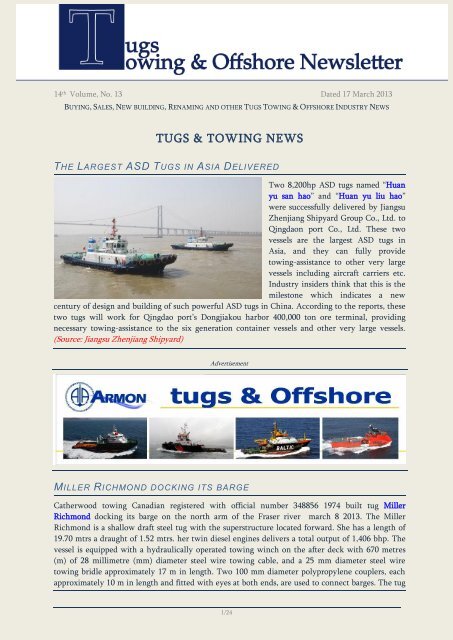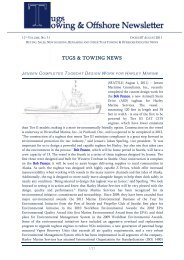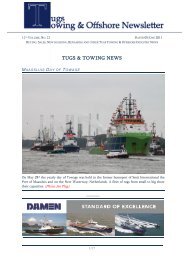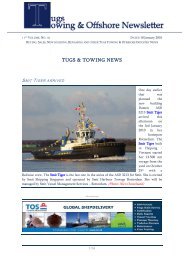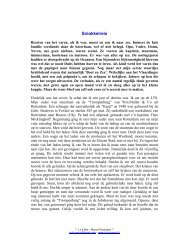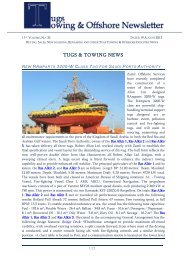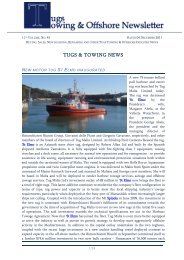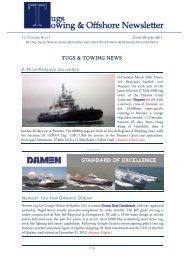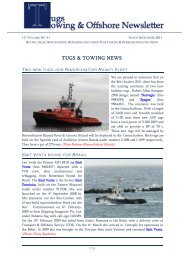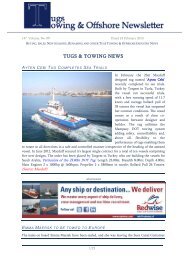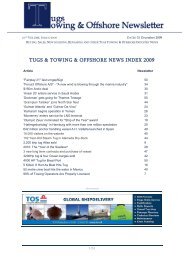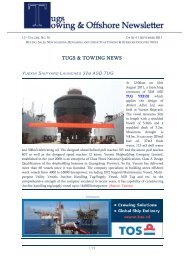Download Newsletter 13 2013 - Towingline.com
Download Newsletter 13 2013 - Towingline.com
Download Newsletter 13 2013 - Towingline.com
You also want an ePaper? Increase the reach of your titles
YUMPU automatically turns print PDFs into web optimized ePapers that Google loves.
14 th Volume, No. <strong>13</strong> Dated 17 March 20<strong>13</strong><br />
BUYING, SALES, NEW BUILDING, RENAMING AND OTHER TUGS TOWING & OFFSHORE INDUSTRY NEWS<br />
TUGS & TOWING NEWS<br />
THE LARGEST ASD TUGS IN ASIA DELIVERED<br />
Two 8,200hp ASD tugs named “Huan<br />
yu san hao” and “Huan yu liu hao”<br />
were successfully delivered by Jiangsu<br />
Zhenjiang Shipyard Group Co., Ltd. to<br />
Qingdaon port Co., Ltd. These two<br />
vessels are the largest ASD tugs in<br />
Asia, and they can fully provide<br />
towing-assistance to other very large<br />
vessels including aircraft carriers etc.<br />
Industry insiders think that this is the<br />
milestone which indicates a new<br />
century of design and building of such powerful ASD tugs in China. According to the reports, these<br />
two tugs will work for Qingdao port’s Dongjiakou harbor 400,000 ton ore terminal, providing<br />
necessary towing-assistance to the six generation container vessels and other very large vessels.<br />
(Source: Jiangsu Zhenjiang Shipyard)<br />
Advertisement<br />
MILLER RICHMOND DOCKING ITS BARGE<br />
Catherwood towing Canadian registered with official number 348856 1974 built tug Miller<br />
Richmond docking its barge on the north arm of the Fraser river march 8 20<strong>13</strong>. The Miller<br />
Richmond is a shallow draft steel tug with the superstructure located forward. She has a length of<br />
19.70 mtrs a draught of 1.52 mtrs. her twin diesel engines delivers a total output of 1,406 bhp. The<br />
vessel is equipped with a hydraulically operated towing winch on the after deck with 670 metres<br />
(m) of 28 millimetre (mm) diameter steel wire towing cable, and a 25 mm diameter steel wire<br />
towing bridle approximately 17 m in length. Two 100 mm diameter polypropylene couplers, each<br />
approximately 10 m in length and fitted with eyes at both ends, are used to connect barges. The tug<br />
1/24
14 TH VOLUME, NO. <strong>13</strong> DATED 17MARCH 20<strong>13</strong><br />
is powered by two diesel engines driving<br />
twin fixed-pitch propellers, with twin<br />
rudders for each propeller. The wheelhouse<br />
is well laid out, with propulsion<br />
controls arranged on the main console<br />
amidships. A second control console is<br />
located at the after end of the boat deck<br />
abaft the funnels. Both control stations<br />
are fitted with pneumatic abort systems<br />
to allow the cable to run freely off the<br />
towing winch drum in the event of an<br />
emergency. (Photo: Robert Etchell)<br />
SAUSE BROS. STAYS FIT THROUGH CLOSE ATTENTION TO THE SHAPE<br />
ITS VESSELS ARE IN<br />
There are different models of fleet<br />
building among tug <strong>com</strong>panies. They<br />
vary according to the firm’s principal<br />
areas of operation, but they will vary<br />
within categories as well. Sause Bros.<br />
Inc., based in Coos Bay, Ore., with<br />
boats stationed in Hawaii, Los Angeles<br />
and Portland, continues to build a fleet<br />
based on the consideration of a wide<br />
range of performance factors. Recently,<br />
<strong>com</strong>pany president Dale Sause took<br />
some time to explain his <strong>com</strong>pany’s<br />
strategy. “It isn’t any one thing that<br />
makes a tug and barge efficient,” he explained. “It is a total of a lot of small things.” With a fleet of<br />
55 tugs and barges, and others being built or purchased, there are a lot of variables to be calculated.<br />
In addition to three crew boats serving the Los Angeles oil islands, they have six L.A.-based tugs,<br />
seven Honolulu tugs and 17 tugs based in Coos Bay. It is a collection of vessels that Sause and his<br />
team take pride in having put together. Growing up around the business when his dad and uncles<br />
ran it, Sause learned to respect a good tug. When his uncle had a heart attack, his dad told him to<br />
finish up his degree at the University of Washington and get back to working with the <strong>com</strong>pany.<br />
That was in the mid-70s and the majority of vessels in the <strong>com</strong>pany fleet were still single screw.<br />
They worked primarily towing lumber scows to California from Canada, Washington and Oregon.<br />
They were doing a little towing to Hawaii, but when the lumber business declined, they grew the<br />
Hawaii business. Sause had taken some engineering courses and understood the importance of<br />
<strong>com</strong>putational fluid dynamics (CFD) in marine design. In 2006 he spent a week in Sweden for tank<br />
testing of hydralift skegs on a new barge design with the late Josip Gruzling of Nautican Research &<br />
Development Ltd., in North Vancouver. Together with Sause’s own engineers, first Jack Wilskey<br />
and later Mark Babcock, and the naval architectural firm Hockema and Whalen, the <strong>com</strong>pany<br />
continues its quest for improved fluid dynamics. This is true for both barges and tugs. Sause Bros.<br />
has its new barges built at Gunderson Marine in Portland. Computer generated profiles show any<br />
turbulence that builds around the bow and stern. The <strong>com</strong>puter allows this to be modeled at various<br />
speeds. The design is then tuned to reduce the turbulence. “A barge shaped like a shoe box has a<br />
2/24
14 TH VOLUME, NO. <strong>13</strong> DATED 17MARCH 20<strong>13</strong><br />
prismatic of 100 percent. As you carve away pieces of the bow and the stern this is reduced,” Sause<br />
explained. “The finer the lines the lower the prismatic. A typical 1970s barge with a rake on the bow<br />
and a cube body had a .88 to .89 prismatic.” Of particular significance to the improved prismatic of<br />
the <strong>com</strong>pany’s barges is the use of Nautican’s hydralift skegs mounted under the stern counter. So a<br />
carefully contoured bow allows good water flow under and around the barge, while the right taper<br />
aft allows the water to flow over the horizontal foil of the skegs and to run cleanly away from the<br />
barge without the tumbling cavitations typical of flat-transomed barges. The <strong>com</strong>pany has about 25<br />
barges. They include a 426-by-105-by-25-foot container barge for the Portland to Hawaii route and<br />
a number of 380-by-76-by-31-foot Bay-class double-hulled oil barges. Souse Bros. currently has its<br />
10th barge building with Gunderson. These latter have been determined to be an optimum size for<br />
towing along the Pacific coast. “By refining the bow and stern, we have been able to bring the<br />
prismatic of these 380-foot Bay-class barges down to .76,” Sause said. While work continues to study<br />
bow waves and turbulence, the <strong>com</strong>pany is paying attention to early research on air injection under<br />
barge bottoms that will further reduce the prismatic. Computer screens in Sause’s office display<br />
turbulence around the hull of the existing barge designs at various speeds. Other methods of<br />
decreasing drag are also being implemented. When the <strong>com</strong>pany launched the tug Mikiona at J.M.<br />
Martinac Shipbuilding in 2007, it was fitted with a Rapp Hydema towing winch. The winch has an<br />
“auto trawl” option developed for <strong>com</strong>mercial fishing trawlers to maintain a steady pull on the net<br />
warps. On the tug it acts like the constant-tension option on a docking tug’s hawser winch. On a<br />
towing winch, it allows the captain to dial in a towing load so that when working in seas, the winch<br />
will allow a little line to pay out and then recover with the surge. A Sause tug might work these<br />
surges with 1,800 feet of the 2,400 feet of two-inch wire that most carry. The wire hangs well down<br />
between the tug and tow to act as a surge or shock absorber. The trawl feature will allow that to be<br />
shortened up to as little as 400 feet. In so doing, a lot of drag is taken out, resulting in improved<br />
towing efficiency, which equals improved speed or fuel consumption. The Sause investment model<br />
tends toward new barges and refurbished tugs — although refurbished might be an understatement<br />
for some of the work that they have done. In November 2012 the Sause tug Tecumseh (ex El Gato<br />
Grande) was on its first tow since an extensive rebuild. Purchased from Tidewater in 2006, the 116by-34-foot<br />
tug was built by American Gulf Shipbuilding in 1979. Sause rebuilt the MAN B&W<br />
12V23L medium-speed engines that each generate 1,740 hp at 800 rpm. The engines turned<br />
controllable-pitch (CP) propellers in Kort 19A nozzles. These have been replaced with high-speed<br />
nozzles and new prop blades. “Computational fluid dynamics showed us that this change would<br />
increase the efficiency by 22 percent. With the CP props, it was an easy job as we kept the same hub<br />
and just bolted on the new blades,” said Sause. “This boat is now matched with the 360-foot doublehulled<br />
oil barge Drakes Bay.” On the tug’s deck, a new Markey towing winch was installed along<br />
Advertisement<br />
with new hydraulic tow pins fabricated in Sause Bros.’ own shipyard. As with all Sause tugs, special<br />
attention is given to <strong>com</strong>fort, especially sound dampening, in the ac<strong>com</strong>modations. Noting that a<br />
3/24
14 TH VOLUME, NO. <strong>13</strong> DATED 17MARCH 20<strong>13</strong><br />
well-rested crew is a safe crew, Sause said, “Studies have shown dramatic effects on rest from engine<br />
noises. It is to our benefit to have well-rested crews.” In November 2012, there were two more tugs<br />
alongside at the Sause headquarters in Coos Bay. Both were being refurbished as time permitted. The<br />
127.7-by-34.8-foot Nakoa (ex. Gulf Runner) was built in 1975 by Service Machinery and<br />
Shipbuilding. Sause will repower it with a pair of 16-cylinder 4000 Series MTU engines each<br />
producing 2,750 hp at 1,800 rpm. With this power the boat will be well suited for towing the larger<br />
426-by-105-foot container barge on the Hawaii route. Also at the Coos Bay dock and moored just<br />
outside Nakoa, the tug Black Hawk was also awaiting new engines. Built in 1968 by Halter Marine<br />
and purchased by Crowley Maritime, the heavily built boat is of particular interest to Sause. “It has a<br />
round chine that no one makes today, as the cost is prohibitive. Today’s boats are single or double<br />
chined. Because of her rounded bottom, the Black Hawk has a prismatic of only .68.” A previous<br />
owner had begun to refurbish Black Hawk with a beautiful upgrade of the wheelhouse, including<br />
some very fine wood joinery done at Point Hope Maritime in Victoria, British Columbia. The<br />
ac<strong>com</strong>modation area includes eight separate staterooms for the crew. These have been redone with<br />
equal quality. Sause shore crews have stripped all the appliances and counters from the galley and<br />
mess area and are currently redoing it to the level of the upper decks. This will be a very<br />
<strong>com</strong>fortable boat. On the aft deck, a set of hydraulic tow pins of Sause’s own design have been<br />
installed, and the whole deck area, including the covered area aft of the main house, has been<br />
sandblasted and will be painted. Extensive steel has been replaced on the bulwarks, as well as on the<br />
bow where new fendering will be installed. A<br />
massive Burrard Iron Works winch has been<br />
overhauled and was protected from the<br />
sandblasting with plywood sheeting. “When<br />
this boat first came out with that winch, our<br />
guys would have marveled at its power and<br />
quality,” explained Sause. “It doesn’t have the<br />
modern controls of the Rapp Hydema, but<br />
these are very good winches.” The most<br />
significant change for Black Hawk will be a<br />
repower. The existing EMD engines will be<br />
replaced by a new set of 12-cylinder MTU engines each developing 1,740 hp at 1,800 rpm and<br />
coupled to Reintjes gears. When <strong>com</strong>plete next July, Black Hawk will be paired with one of the 360by-105-foot<br />
Bay-class barges, and can fill in on the Hawaii run. Black Hawk will also receive three<br />
new auxiliaries. Speaking of the quite different work being done on Nakoa and Black Hawk, Sause<br />
said, “Our model tends to be more long term with regard to cost recovery, although to repower and<br />
refurbish the Black Hawk will cost about $4 million. To build a new tug of this size with a doublechine<br />
hull would cost about $12 million. To build a tug with this rounded-chine hull would cost<br />
more like $15 million.” Sause added that the operational model for the tugs is equally important if<br />
they are to be profitable. “We generally operate at 72 to 82 percent of our available power range<br />
except in a weather emergency,” he explained. “We optimize fuel and engine life with speed over<br />
the ground for best fuel consumption at the best speed for a timed arrival. You don’t rush to arrive<br />
before there are shore crews available. The captain uses an onboard <strong>com</strong>puter program to set<br />
parameters. Our dispatch has the same program and can counsel the captain. Whenever we suggest a<br />
change from the office, it is always prefaced with ‘If you can do it safely.’ The captain is the final<br />
arbitrator of that.” “There are situations where, even with good weather, the questions is asked, ‘Is it<br />
worth burning an extra 6,000 gallons of fuel over 48 to 72 hours to make a deadline?’ But this<br />
be<strong>com</strong>es a marketing decision. In 1999 our port engineer, the late Jack Wilskey, predicted fuel<br />
would reach a dollar per gallon and encouraged the building of hydrodynamic-efficient equipment,”<br />
4/24
14 TH VOLUME, NO. <strong>13</strong> DATED 17MARCH 20<strong>13</strong><br />
Sause explained. “Now fuel is much higher and EPA air emissions have been a driver that we have<br />
had to pay for with fuel efficiency.” The fuel burn versus engine hours is an issue that gets attention<br />
at Sause Bros. “We visited many of the major engine manufacturers’ plants,” Sause explained.<br />
“We’ve been doing life-cycle modeling for 10 years now. We wanted to see for ourselves how they<br />
reached their time-between-overhaul (TBO) estimates. While quality was high at a number of<br />
factories, we were most impressed with the European standards of MTU. Each part of the engine has<br />
some measure of TBO.” That is not to say that there are no failures in equipment at Sause, but when<br />
a failure does occur, it is analyzed for cause. Recently the <strong>com</strong>pany had a failure in a high-pressure<br />
fuel pump. It was nearing time for its scheduled overhaul, but investigation showed that when<br />
California introduced its requirements for ultra-low sulfur fuels, not all fuel producers put in enough<br />
additive to make up for the lack of lubricity. “We now test more of our fuel, even though additives<br />
have improved,” Sause said as one more example of the detailed attention that has led this secondgeneration<br />
family <strong>com</strong>pany to continued success in a challenging and <strong>com</strong>petitive world. (Source &<br />
Photos: by Alan Haig-Brown Professional Mariner)<br />
Advertisement<br />
DETAINED TUGS SLIP AWAY IN THE NIGHT<br />
A tug that ran aground in Newlyn<br />
harbour on Thursday, February 28,<br />
20<strong>13</strong>, and was then detained and<br />
condemned as unseaworthy refloated<br />
and slipped out of the port in the dead<br />
of night. The vessel – one of two to<br />
disappear on Sunday – was held after<br />
major defects were found by Maritime<br />
and Coastguard Agency surveyors.<br />
The Juliette Pride II (Imo 4903389)<br />
beached while trying to manoeuvre<br />
round the harbour at low tide. An<br />
investigation has been launched and<br />
the boats, both flying the flag of Tanzania, are thought to be bound for Africa. MCA officials say the<br />
boats may sink and they fear for the Nigerian crews and anyone <strong>com</strong>ing to their aid. "We prohibited<br />
them from setting sail but once they hit international waters it's tricky to get them back," said Jo<br />
Rawlings, spokesman for the MCA. "Detention orders are only issued when vessels are deemed<br />
unsafe." The boats are thought to have had their tracking systems turned off and Falmouth<br />
Coastguard has been unable to find a radar trace. The Juliette Pride II is the former dog class tug<br />
5/24
14 TH VOLUME, NO. <strong>13</strong> DATED 17MARCH 20<strong>13</strong><br />
Husky from RMAS with pennant number A178 as from 2008 Serco Denholms SD Husky(Source:<br />
www.thisiscornwall.co.u k/buyaphoto)<br />
NERO ON TECHNICAL TRAILS<br />
On Friday 8th the new building<br />
Damen Hardinxveld Multicat 30<strong>13</strong><br />
yard number 571678) Nero (Imo<br />
9641481), for ST Marine Support –<br />
Harlingen; Netherlands was seen<br />
in the Rotterdam Caland Canal<br />
<strong>com</strong>mence bollard pull trails. The<br />
vessel has a length o.a. of 30.30<br />
mtrs a beam of 12.50 mtrs a depth<br />
at sides 3.80 mtrs. The three<br />
Caterpillar 3412D TTA develops a<br />
total output of 1,866 bkW (2,500<br />
bhp) at 1,800 rpm. It is expected<br />
that she achieved a bollard pull of<br />
35 tonnes and a speed of 9.6 knots.<br />
Her basic functions are Anchor handling, dredger service, supply, towing, hose handling and survey.<br />
She is classed I Tug Unrestricted navigation • MACH, AUT-UMS NAT. AUTHORITIES Dutch<br />
Shipping Inspectorate (IVW): Unrestricted service. She is the sister of the Odin. The vessel was<br />
christened on Friday 15 th March by the sponsor lady Jennifer Tammes, daughter of co-owner Vasco<br />
Tammes after de vessel was handed over to the owners. (Photo: Jan Oosterboer)<br />
NEPTUN 11 TOWING THE STEMAT 76 ENTERING MALTA<br />
The 2011 built Gibraltar<br />
registered with call sign<br />
ZDKE9 tugboat Neptun 11<br />
(Imo 9571208) was seen<br />
towing the 50m flat top barge<br />
Stemat 76 entering Grand<br />
Harbour, Malta on Friday 8th<br />
March, 20<strong>13</strong> <strong>com</strong>ing from<br />
Casablanca, Morocco. The tug<br />
is owned by Neptune Marine<br />
Towage VI BV – Sliedrecht;<br />
Netherlands and managed by<br />
Landfall Transport & Towage<br />
BV – Sliedrecht; Nehterlands.<br />
She is built by Panyu Yuefeng Ship Building & Repairing Factory – Panyu; China under number<br />
YD12. The two main engines develops a total output of 2,388 kW (3,244 hp) and the speed is 12<br />
knots. The Neptun 11 has a length o.a. of 36.00m mtrs a beam of 10.40 mtrs and a depth of 5.00<br />
mtrs. Her grt is 459 tonnes and her nrt <strong>13</strong>7 tonnes. She is classed Bureau Veritas I Hull Mach<br />
Unrestricted navigation AUT-UMS (SS) nr.16230T(Photo: Capt. Lawrence Dalli -<br />
www.maltashipphotos.<strong>com</strong>)<br />
6/24
14 TH VOLUME, NO. <strong>13</strong> DATED 17MARCH 20<strong>13</strong><br />
COAST GUARD RESPONDS TO SUNKEN TOWING VESSEL IN MISSISSIPPI<br />
RIVER<br />
The Coast Guard is continuing to respond to<br />
a sunken towing vessel in the Mississippi<br />
River near St. James, Friday 8 th March.<br />
Mckinney Salvage and Heavy Lift are<br />
scheduled to arrive on scene tonight and<br />
<strong>com</strong>mence salvage operations. Coast Guard<br />
Sector New Orleans watchstanders received<br />
a report around 2 a.m. Thursday that the<br />
56-foot towing vessel Justice, owned by<br />
River Ventures LLC, had begun taking on<br />
water and sank around midnight. Three<br />
people aboard the tow vessel were able to<br />
get off the vessel before it sank. The vessel<br />
was carrying 5,336 gallons of diesel fuel and 100 gallons of lube oil when it sank. The actual amount<br />
of fuel discharged into the Mississippi River is unknown at this time; however, current estimates<br />
indicate the full amount of fuel and oil carried aboard the vessel has not released into the water.<br />
Divers were able to plug the fuel vents Thursday. Coast Guard responders have been on scene to<br />
oversee pollution response operations since approximately 6 a.m., Thursday. Boom has been<br />
deployed, and the Coast Guard is continuing to monitor the situation to identify shoreline impacts.<br />
The Lower Mississippi River Waterworks Network is currently monitoring water intakes in the<br />
area, but there have been no impacts to drinking water and none are expected. The Coast Guard is<br />
investigating the cause of the incident. On the picture the Justice as Rosedale (Source: U.S. Coast<br />
Guard; Photo by Mark Haury) Update: Tug raised by crane: A heavy lift crane hoisted the Justice<br />
from the bottom of the Mississippi River and refloated it on Mar 7 in St. James Parish. McKinney<br />
Salvage and Heavy Lift Inc. of Baton Rouge, arrived on scene in the morning and were able to lift<br />
the vessel which was expected to remain on the water for a few days. The Justice went down<br />
around midnight on Mar 5 after taking on water. Three crew members aboard the tug were able to<br />
get off before it sank. It had just finished moving a barge. Coast Guard responders had been<br />
overseeing pollution response operations since 6 a.m. Mar 6. Floating containment boom had been<br />
deployed around the vessel as it rested on the river bottom, and Coast Guard personnel were<br />
watching for any effects on the shoreline. The Coast Guard was investigating the cause of the<br />
incident. (Update: Vesseltracker)<br />
Advertisement<br />
7/24
14 TH VOLUME, NO. <strong>13</strong> DATED 17MARCH 20<strong>13</strong><br />
FIRE ON DUTCH TUG LINGE<br />
On Friday 8 th March on the<br />
Amsterdam-Rhine Canal near Maarssen<br />
a fire had broken out on the pusher<br />
Linge. The fire would have originated<br />
in the engine room and was briefly<br />
folding. The fire, by the fire brigade was<br />
called as a grounded fire, two firefighting<br />
vehicles, a foam truck and a fire<br />
boat were sent to the spot. At the height<br />
of the Oostkanaaldijk fire fighters could<br />
approach the boat after the fire was<br />
quick under control. The Linge was<br />
built 1971 by Zorg en Vlijt H. de Haas,<br />
Maassluis; Netherlands under number 158 for N.V. H.Zwaak Jr. – Rotterdam as Neptunus 6. On the<br />
1 st March transferred sold to Smit–Vos–Zwaak Rivier en Duwvaart B.V., Rotterdam. On the 24 th<br />
December 1981 sold N.V. Stoomsleepdienst “Mars”, Rotterdam and renamed Mars VI. On the 18 th<br />
January 1984 sold to Smit Internationale Havensleepdiensten B.V., Rotterdam. On the 22 nd June<br />
1988 transferred to Smit Havensleepdiensten B.V., Rotterdam and renamed Linge. On the 1 st August<br />
1992 transferred to Interriver B.V., Rotterdam. On the 4 th November 1994 sold to Bergings–en<br />
Transport Maatschappij Scheffer, Lelystad; Netherlands. On the 16 th April 2002 sold to Koninklijke<br />
Wagenborg B.V., Delfzijl On the 1 st May 2004 sold to Bergings– en Transport Mij. BTS B.V.,<br />
Schiedam. In 2009 BTS was absorbed by Mammoet Salvage BV – Schiedam; Netherlands. (Source:<br />
http://koopvaardij.blogspot.nl/; Photo: Marcel Coster)<br />
LAVAN TO BE RENAMED SVITZER EUROMED<br />
The 1988 built St. Vincent & Grenadines<br />
registered with call sign J8B4566 tugboat<br />
Lavan (Imo 8714255) was seen berthed at<br />
Pinto 2,Grand Harbour, Malta on Thursday<br />
7th March, 20<strong>13</strong> in prior to change name<br />
into Svitzer Euromed. The tug is owned by<br />
Svitzer Euromed B.V. – Lisbon; Portugal and<br />
managed by Svitzer Lisboa-Reboques –<br />
Lisbon: Portugal. She has a grt of 429 tonnes<br />
and a dwt of 400 tonnes and is classed Lloyds<br />
Register of Shipping. (Photo: Capt. Lawrence<br />
Dalli - www.maltashipphotos.<strong>com</strong>)<br />
TUGS & BARGES CONFERENCE & EXPO SERIES<br />
An essential forum for owners,<br />
operators, designers, builders,<br />
regulators and suppliers to discuss<br />
the key issues that impact the tug<br />
and barge market. Marine Log's<br />
Tugs & Barges Conference & Expo once again presents marine executives with an engaging, lively<br />
8/24
14 TH VOLUME, NO. <strong>13</strong> DATED 17MARCH 20<strong>13</strong><br />
agenda highlighting operational and technology trends in the tug and barge market. Central to the<br />
program is safety, the economy, and the environment. Liquefied natural gas, for example, is<br />
presenting intriguing opportunities in the technology, operations and downstream markets. LNG is<br />
abundant and cheap in the U.S. and several operators have already <strong>com</strong>mitted to building vessels that<br />
will use LNG as fuel. On the downstream side, there's ample opportunity for LNG bunkering barges -<br />
particularly in light of Shell's recent announcement. Join us May 21-22, 20<strong>13</strong> at the Stamford<br />
Marriott in Stamford, CT to discuss LNG and much more with some of the foremost experts in the tug<br />
and barge field. View the program online now and register for this crucial conference and expo.<br />
(Press Release Marine Log)<br />
DUKE LAUNCHED<br />
Advertisement<br />
Last week at the Gebr. Kooiman Shipyard<br />
– Zwijndrecht; Netherlands was seen<br />
yard number 200 the tug Duke II (Imo<br />
9677947) which was launched in the<br />
early morning. The hull of the tug was<br />
built by the Barkmet Shipyard in Usti<br />
nad Labem. The outfitting of the tug was<br />
performed at the Zwijndrecht shipyard.<br />
The vessel is built for Probus Mare<br />
Marine Ltd. She has a length o.a. of 34.30<br />
mtrs a length b.p. of 30.20 mtrs a breadth<br />
moulded of 11.00 mtrs and a mean<br />
draught of 4.05 mtrs. Het grt is 435<br />
tonnes and a the nrt is 126 tonnes. He<br />
two Mitsubhi S12U-MPTK main engines develops a total output of 4,410 kW. It is expect that she<br />
achieved a board pull during trails of 83 tons. He is classed Bureau Veritas with notation I✠Hull ●<br />
Mach Unrestricted navigation AUT-UMS; Ice class 1A super. (Photo: Piet van Roon)<br />
EDDA CAUGHT FIRE<br />
The pusher tug Edda (EU-No. 05609510-25.66-m) caught fire on Feb. 28 on the Mittelland Canal<br />
near Lohnde due to a technical malfunction in the kitchen in the stern region. The living rooms in<br />
the aft were <strong>com</strong>pletely gutted. The amount of damage was not yet clear. The local fire brigades<br />
tackled the flames with foam and water, the canal was closed for ship traffic until 1500LT. (Source:<br />
Countryman)<br />
9/24
14 TH VOLUME, NO. <strong>13</strong> DATED 17MARCH 20<strong>13</strong><br />
GULF SPRAY - SIGN OF SPRING<br />
TIOGA B OPERATE ON THE WEST COAST OF SCOTLAND<br />
10/24<br />
The hardworking tug Gulf Spray was<br />
hauled out on the IEL dock this week for a<br />
refit. After being "evicted" by public<br />
pressure from its long-time home near the<br />
old CN Pier last year, the tug was laid up<br />
for the winter somewhere in the lower<br />
Burnside area. Used for transferring<br />
garbage barges from cruise ships, the tug<br />
does useful work in the harbour. Built in<br />
Pictou in 1959 it was extensively rebuilt in<br />
2007. It is a single screw tug with a fixed<br />
nozzle. (Source: Mac Mackay-Tugfax)<br />
From a bright and sunny West coast of Scotland.<br />
We have the Tioga B on the Clyde for the next<br />
few weeks. She is tasked to assist the dredger<br />
WD Mersey in dredging operations around the<br />
river. Seabed survey and levelling work will be<br />
her main work. The tug, a Delta 1575 type, is<br />
built in 1981 by Deltawerft BV – Sliedrecht;<br />
Netherlands and ordered by the Belgian Marine<br />
but never delivered. She was delivered to<br />
Felixarc Marine Ltd and managed by Timothy<br />
Gray – Felixtowe as Gray Delta. In 1991 sold to<br />
James Fisher & Sons plc - Barrow-in-Furness and<br />
chartered to Klyne Tugs (Lowestoft) Ltd – Lowestoft; Britain and renamed Anglian Maid. In 1995<br />
sold to Bay Towage & Salvage Co Ltd – Barrow; Britain and renamed Tioga B. She has a length of<br />
15.93 mtrs a beam of 5.30 mtrs and a depth of 2.20 mtrs. The two GM type 12V71N diesel engines<br />
has a total output of 730 bhp. The speed is 10 knots and the bollard pull 11 tonnes. (Source: Tommy<br />
Bryceland, Scotland)<br />
TOS DELIVERS ASD TUG LOMAX FOR ØSTENSJØ REDERI<br />
TOS is proud to conduct the first ship<br />
delivery for Østensjø Rederi, a maritime<br />
service <strong>com</strong>pany based in Norway. “The ASD<br />
tug Lomax has been built by Sanmar (Turkey,<br />
Tuzla) a yard which we have done business<br />
with for many years now. They brought us in<br />
touch with Østensjø.” says Ronald van der<br />
Kolk, Manager Division Nautical &<br />
Technical. March 7th the Lomax arrived at<br />
the port of Ulsteinvik, Norway to deliver a<br />
tow. The vessel Lomax picked up the tow in
14 TH VOLUME, NO. <strong>13</strong> DATED 17MARCH 20<strong>13</strong><br />
the Ukraine. The tow is the new build casco X-BOW vessel Blue Guardian from the <strong>com</strong>pany<br />
Ulstein and was delivered to a ship yard in Ulsteinvik. After this she will continue her voyage to a<br />
renewed destination. The Lomax sails under full TOS management and with a TOS crew. (Source:<br />
TOS)<br />
Advertisement<br />
View the youtube film of the Alphabridge for tugboats on http://www.youtube.<strong>com</strong>/watch?v=hQi6hFDcHW4&feature=plcp<br />
ROSENBERG ENGINE FAILURE<br />
The Swedish tug Rosenberg (<strong>13</strong>2-gt) suffered engine failure in rough seas and strong winds on Mar.<br />
7. The crew was hoisted by a Danish rescue helicopter and taken to Trelleborg, where police and<br />
ambulance showed up. Several attempts were made in vain to connect to the disabled vessel.<br />
(Source: Countryman)<br />
ACCIDENTS – SALVAGE NEWS<br />
USS GUARDIAN SALVAGE MAY TAKE TILL APRIL<br />
No thanks to recent delays from<br />
bad weather, salvage work on the<br />
grounded minesweeper USS<br />
Guardian may go beyond Holy<br />
Week or end-March, the<br />
Philippine Coast Guard said<br />
Friday. Coast Guard Palawan and<br />
Task Force Tubbataha head<br />
Commodore Enrico Evangelista<br />
said they may even work until<br />
the second week of April, radio<br />
dzBB's Carlo Mateo reported.<br />
Evangelista was quoted in the<br />
report as saying that with the delays brought by bad weather, it is not impossible they may go<br />
beyond the original deadline of March 23. He said they are also not discounting the possibility they<br />
may go beyond Holy Week, the last week of March. Earlier this month, big waves and strong winds<br />
forced salvage crews to suspend work on extricating the USS Guardian from Tubbataha Reef. While<br />
salvage work has since resumed after the weather improved, Evangelista said they are entering a<br />
critical phase of the operation. He said they are now focusing on removing a part of the deck, and<br />
may need five to six days to cut the hull into three sections. (Source: KG, GMA News; Photo: U.S.<br />
Navy)<br />
11/24
14 TH VOLUME, NO. <strong>13</strong> DATED 17MARCH 20<strong>13</strong><br />
GO OFFSHORE’S VESSEL IN COLLISION INCIDENT (AUSTRALIA<br />
This morning an incident occurred between<br />
one of Go Offshore’s vessels, the DP1 Safety<br />
Standby Service Vessel ’FOS Polaris’ and<br />
another vessel approximately 1km off the<br />
coast of Exmouth, Australia, No one was<br />
injured in the incident. GO MARINE<br />
GROUP said in a statement it was working<br />
with the Department of Transport and other<br />
relevant agencies to manage the incident.<br />
(Source: GO Offshore)<br />
BARGE SINKING OFF COAST OF HOOKER'S POINT<br />
12/24<br />
Hillsborough County -- The coast guard is<br />
checking out a mud barge that is sinking<br />
off Hooker's Point in Hillsborough<br />
County. Coast guard officials are sending a<br />
pollution expert out to make sure it's not<br />
an environmental concern, which they<br />
don't believe it is. No one was hurt.<br />
(Source: Bay News 9)<br />
COAST GUARD RESPONDS TO ALLISION, OIL SPILL SOUTH OF NEW<br />
ORLEANS<br />
The Coast Guard is responding to a<br />
report of an allision between a tug<br />
pushing a barge and a pipeline near<br />
Bayou Perot 30 miles south of New<br />
Orleans, Tuesday. Coast Guard<br />
Sector New Orleans watchstanders<br />
received a report that the 47-foot<br />
tug Shanon E. Settoon was pushing<br />
a 154-foot oil barge when it allided<br />
with a pipeline 6 p.m., Tuesday. All<br />
crew members were able to exit the<br />
tug; the captain reportedly suffered<br />
second to third-degree degree<br />
burns. A Coast Guard Air Station New Orleans MH-65D dolphin helicopter crew and and a 24-foot<br />
Special Purpose Craft — Shallow Water from Coast Guard Station Grand Isle have responded to the<br />
allision. The MH-65 Dolphin helicopter crew confirmed the vessel was on fire. There have been<br />
reports of oil in the water. ES&H has been hired as the oil spill response organization. "We are<br />
aggressively responding with our state and local partners to mitigate the fire and prevent any
14 TH VOLUME, NO. <strong>13</strong> DATED 17MARCH 20<strong>13</strong><br />
potential impacts from oil that entered the water, " said Cmdr. Russ Bowen, incident <strong>com</strong>mander,<br />
Sector New Orleans. The Coast Guard is working with federal, state and local agencies in response<br />
to this incident to ensure the safety of responders and contain and clean up any oil that is leaking.<br />
(Source: USCG; Photo: G.Herbert)<br />
Advertisement<br />
TUG ALLIDED WITH PIER IN NEWCASTLE<br />
On Mar 11, 120<strong>13</strong>, the "Svitzer Myall" allided<br />
with a pier in Newcastle, Australia, around 3<br />
p.m. The vessel began taking on water and had to<br />
be assisted by several other tugs and harbor work<br />
staff to <strong>com</strong>e into port. A technical failure was<br />
blamed for the accident. None of the crew were<br />
injured in the allision. (Source: Vessetracker)<br />
OFFSHORE NEWS<br />
LAUNCH OF A CONCEPT: THE ARCTIC MINOR TEAM<br />
On the last day of January this year, five<br />
Maritime Engineering bachelor students of<br />
the Delft University of Technology;<br />
Netherlands finished their a semester of<br />
studies. An unusual semester, characterized<br />
by an unique opportunity that these students<br />
took: a minor on Arctic engineering. This<br />
article aims to explain the 'why' , 'how' and<br />
results of this endeavour. These days, a<br />
bachelor in Maritime Engineering consists of<br />
more that the courses on hydrodynamics,<br />
structures and propulsion. The concept of a<br />
minor is introduced, a semester of the bachelor dedicated to deepening or widening knowledge on a<br />
<strong>13</strong>/24
14 TH VOLUME, NO. <strong>13</strong> DATED 17MARCH 20<strong>13</strong><br />
certain subject. Numerous minors are available from the Delft University of Technology, ranging<br />
from advanced courses on mathematics to product design. And then there is Toptrack, the<br />
excellence program of the 3mE faculty, offering students the unique opportunity to arrange their<br />
own minor and fill it up with master courses. Add to this mix five enthusiastic and creative students<br />
and you have yourself a custom minor. 'Not taking the easy way out', was an often heard quote<br />
while looking for a subject. One of the least easy ways in Maritime Engineering seemed to be the<br />
Arctic, where a harsh climate hampers all operations and the danger of ice lurks at all times. The<br />
exact definition of the minor was starting to take shape. One part would be courses, the other a<br />
project on a ship sailing through the Arctic. Due to the lack of courses <strong>com</strong>bining ice and ships at<br />
the TU Delft, another university was to be found. The Aalto university in Helsinki proved to be the<br />
right place, with three courses on ice in the right time of the year. For a realistic project the help of<br />
the industry was sought. Several <strong>com</strong>panies based in The Netherlands were visited and all offered a<br />
project related to the Arctic. In the end the <strong>com</strong>bination of Damen, Marin and DNV was chosen: the<br />
design of an Arctic Offshore Support Vessel. Combining a shipbuilder, research institute and<br />
classification society led to a <strong>com</strong>plete view on shipbuilding, from design to delivery. In Finland a<br />
lot was learned about the ships in ice. The course Ship Performance in Ice taught us to predict and<br />
test resistance in ice.<br />
Risk Analysis of<br />
Structures in Ice gave<br />
an introduction on risk<br />
based design. Arctic<br />
Offshore Structures<br />
gave the freedom to<br />
make calculations on a<br />
real vessel, in our case a<br />
ship supplied by<br />
Damen. The project<br />
contained three parts.<br />
First a literature study,<br />
to <strong>com</strong>plement the<br />
courses with knowledge on the environment, the market and the geography. Second a <strong>com</strong>parison<br />
study, extending the Arctic Offshore Structures course to make calculations on three Damen vessels<br />
in order to get more experience with offshore vessels. The final report was a design, where the<br />
Arctic Minor Team <strong>com</strong>bined the experiencefrom the courses and previous reports into one<br />
innovative concept, launched at January 31st.The vessel, named AMTSV 003 after Arctic Modular<br />
Towing Supply Vessel third iteration, is a near 100 m supply ship, capable of operating the Barents<br />
Sea year round and in Baffin Bay and Beaufort Sea for 8 months. The ship features cargo capacities<br />
<strong>com</strong>parable to other supply ships nearly equal in size. No <strong>com</strong>promises on crew conditions are made,<br />
by allowing the crew to work in the Enclosed Superstructure, as seen behind the superstructure. Ice<br />
handling can be performed by the thrusters, as well as by towing icebergs away from an offshore<br />
platform, using the 'Towing' capabilities. All in all this project learned the team about cooperation,<br />
working in a foreign environment and most of all Arctic shipbuilding. A project to develop and<br />
eventually put on ice. Participants: Reinier Bos, John Huisman, Martijn Obers, Tobias Schaap en<br />
Max van der Zalm. Supervisors: Peter de Vos. Partners: “DAMEN”, “DNV” en “MARIN”. (Source:<br />
Young Maritime International; Thanks to Max van der Zalm and his team for permission to add the<br />
article in the TT&O)<br />
14/24
14 TH VOLUME, NO. <strong>13</strong> DATED 17MARCH 20<strong>13</strong><br />
NEW STATOIL CONTRACTS FOR THE PSVS HAVILA CLIPPER & HAVILA<br />
CRUSADER<br />
Advertisement<br />
CEONA HIRES GC RIEBER SHIPPING’S NEWBUILD CSV<br />
15/24<br />
Havila Shipping has entered into new<br />
contracts with Statoil for PSV vessels<br />
Havila Clipper and Havila Crusader.<br />
The Havila Clipper contract is for a<br />
firm period of four months with four<br />
optional periods for one month. The<br />
Havila Crusader contract is for a firm<br />
period of six months with two optional<br />
periods each of three months. Both<br />
vessels will start working under new<br />
charter contract early in April. The<br />
contracts are at market terms. (Press<br />
Release Havila Shipping)<br />
GC Rieber Shipping<br />
ASA has entered into a<br />
charter agreement<br />
with Ceona Services<br />
(UK) for its high<br />
capacity subsea<br />
newbuild for a fixed<br />
period of 5 years, with<br />
options for up to five<br />
years. The vessel will<br />
<strong>com</strong>mence working<br />
for Ceona immediately<br />
upon delivery from<br />
Ulstein Verft in the first quarter of 2014. Ceona is a London-based SURF-player and aims to grow<br />
their position as a global subsea <strong>com</strong>pany. Ceona is majority-owned by GS Capital Partners funds.<br />
“GC Rieber Shipping has strengthened its position in the high end subsea segment over the last
14 TH VOLUME, NO. <strong>13</strong> DATED 17MARCH 20<strong>13</strong><br />
years. We look forward to cooperating with Ceona in the years to <strong>com</strong>e” says CEO Irene W. Basili in<br />
GC Rieber Shipping. The newbuild contract was placed in June 2012 at an investment of<br />
approximately NOK 800 million, with GC Rieber Shipping holding an option for one additional<br />
vessel. After entering into this contract, GC Rieber Shipping has a total backlog of about NOK 3,5<br />
billion. The high-capacity newbuild is a construction support vessel (CSV) designed for operations in<br />
harsh and deep waters, with a length of <strong>13</strong>0 meters and a 25 meter beam. The vessel is built to the<br />
highest standard for dynamic positioning, DP-3, and is equipped with a 250t AHC offshore crane.<br />
The ship is designed to operate in the SURF market, with capacity for pipe loads below deck and on<br />
main deck, and a vertical pipe laying system above the moon pool. The ship can ac<strong>com</strong>modate <strong>13</strong>0<br />
crew, and is built according to the latest international environmental standards. Ceona will equip<br />
the vessel with a 270 t vertical lay system (VLS). (Press Release)<br />
BATAM SHIPYARD COMPLETES MPSV ENDEAVOUR UPGRADE WORKS<br />
Miclyn Express Offshore has announced<br />
the <strong>com</strong>pletion of upgrading works on<br />
MPSV Endeavour. This project was<br />
undertaken by a specialised team based<br />
in MEO’s Batam shipyard. The team has<br />
had previous experience with upgrading<br />
works such as jumboisation, DP2<br />
upgrading and <strong>com</strong>plicated vessel<br />
conversions. Endeavour has undergone<br />
various upgrading works including cable<br />
laying and installation of a taut wire skid<br />
foundation. The mezzanine deck was<br />
extended by an additional 6m x 4m with<br />
a Launch and Recovery Systems (LARS) ensuring that she can handle ROV lifting works while<br />
giving more space on main deck for the remaining ROV spread. A new four man cabin has also been<br />
added to further expand her ac<strong>com</strong>modation capacity to 55 men, enabling more special purpose<br />
personnel to stay onboard. (Press Release Miclyn)<br />
ULSTEIN VERFT LAUNCHES PSV BLUE THUNDER<br />
Last weekend was hectic at Ulstein Verft, as<br />
three PSV sisters of the PX121 design were<br />
on the move. Yno 296, Blue Thunder, was<br />
launched on Saturday 9 March, and is now<br />
situated quayside, bright and blue. The hull<br />
of yno 298 was docked into the dock hall<br />
for outfitting. While the newly delivered<br />
Blue Power, left on Friday for her first<br />
assignment in the spot market. (Source:<br />
Ulstein)<br />
16/24
14 TH VOLUME, NO. <strong>13</strong> DATED 17MARCH 20<strong>13</strong><br />
YARD NUMBER 125 LAUCHED AND UNDER CO NSTRUCTION<br />
Advertisement<br />
SALE OF RRV VESSEL HAVILA RUNDE<br />
17/24<br />
Last week on the 9 th March yard<br />
number 125 was successfully sea<br />
launched at Simek Shipyard. The<br />
superstructure was lifted onto the hull<br />
the other day on the 10 th March. The<br />
ship will be delivered to Atlantic<br />
Offshore in May 20<strong>13</strong>. The UT 755 LC<br />
designed vessel will be named<br />
Atlantic Scout Main Particulars:<br />
Length o.a. 76,60 m; Length p.p. 68,20<br />
m; Beam 16,00 m; Depth, main deck<br />
7,00 m; Draught, loaded 5,80 m; Class:<br />
Det Norske Veritas (Source: Simek)<br />
Havila Shipping ASA has, on behalf of the<br />
100% owned ship owning <strong>com</strong>pany Havila<br />
Offshore AS, entered into an agreement<br />
where the RRV vessel Havila Runde (Imo<br />
9163025) is sold to Secunda Canada. The<br />
selling price is at booked value of the vessel<br />
and the sale will release liquidity of around<br />
MNOK 30. The sale is expected to be<br />
<strong>com</strong>pleted this month. Havila Runde is built<br />
in 1997 and after sale of the vessel Havila<br />
Shipping operates only three vessels built<br />
before 2003. She is a PSV – Stand-by-Rescue design. Built by Kværner Kleven Leirvik. (Press Release<br />
Havila)<br />
GRANDWELD SHIPYARDS WINS ANOTHER CONTRACT FOR 42M<br />
ALUMINUM CREW BOAT<br />
Dubai, United Arab Emirates, March 10, 20<strong>13</strong>: Grandweld Shipyards has been awarded a contract to
14 TH VOLUME, NO. <strong>13</strong> DATED 17MARCH 20<strong>13</strong><br />
build a 42M Aluminum Crew Boat for<br />
Maroos Shipping. Grandweld signed the<br />
deal with the renowned provider of<br />
integrated shipping, and marine services on<br />
the 10th March 20<strong>13</strong>. The contract follows<br />
previous delivery of a 38M Utility Vessel to<br />
Maroos Shipping in March 2012. The new<br />
42M Aluminum Crew Boat is based on<br />
Grandweld’s existing proven design, and<br />
can reach speeds in excess of 25 knots. It<br />
benefits from luxury seating,<br />
ac<strong>com</strong>modation for VIP guests, a larger<br />
deck space and enhanced <strong>com</strong>fort for the crew. The vessel can seat 83 passengers and has a 110sqm<br />
loading area for over 90 tons of deck cargo. It can also carry a large amount of fuel and freshwater.<br />
The contract with Maroos Shipping is the latest in a string of recent orders for the 42M Aluminum<br />
Crew Boat. It follows orders for the boat from Wesal Shipping in October 2012, and three for Global<br />
Marine, signed in August 2012. The huge success of the 42M is down to its highly advanced design,<br />
plus a focus on safety and security. Crew boats have be<strong>com</strong>e an increasingly <strong>com</strong>mon feature in the<br />
Gulf region; a quality vessel such as the 42M will always attract plenty of new and repeat business.<br />
(Press Release Grandweld)<br />
TOR VIKING AND BALDER VIKING RELEASED BY SMA<br />
Swedish Maritime Administration (SMA) has<br />
decided not to extend the charter contracts for<br />
AHTS icebreakers Tor Viking and Balder Viking.<br />
The vessels have since 1999/2000 been available to<br />
SMA every Q1 for icebreaking duties, the vessels<br />
will end the contract after Q1 2014 and Q1 2015<br />
respectively. SMA had options thereafter, which<br />
will not be utilized. The prevailing financial terms<br />
of the SMA contract entered into in 1998 does not<br />
reflect current market rates. In addition it imposed a<br />
limitation for Viking Supply Ships to offer the<br />
vessels for other charterers. The release now enables<br />
the <strong>com</strong>pany to offer the vessels for long term contract opportunities world-wide. (Press Release<br />
Vinking Supply)<br />
BUMI ARMADA BERHAD BUYS MPSV FROM CONDOR SHIPCO<br />
Malaysia-based international <strong>com</strong>pany, Bumi Armada Berhad announced that its wholly-owned<br />
subsidiary, Bumi Armada Offshore Contractor Limited has acquired and taken delivery of a MPSV<br />
(multipurpose platform support vessel) from Condor Shipco Limited for USD15.8 million. The DP2<br />
diesel electric vessel which was re-named Armada Condor was re-built in 2002 which involved<br />
extension of vessel length, addition of DP2 system and thrusters. The DNV-classed support vessel<br />
measures 104 metres in length with a beam of 22.4 metres; it features a 120 tonne main crane with<br />
Active Heave Compensation system for operation up to 2000 m water depth, an auxiliary crane, a<br />
cargo crane, moon-pool, helideck and built-in gas storage of 14,800 cubic metres. It has 1,100 square<br />
18/24
14 TH VOLUME, NO. <strong>13</strong> DATED 17MARCH 20<strong>13</strong><br />
metres of deck space with deck load capacity of 1,300 tonnes and hydro acoustic to 2,000 m. The<br />
Armada Condor has ac<strong>com</strong>modation for 127 persons. (Source: Bumi Armada)<br />
VIKING SUPPLY SHIPS A/S HAS SIGNED NEW LONG TIME CHARTER<br />
CONTRACT<br />
Viking Supply Ships A/S (VSS) has<br />
entered into a time charter contract for<br />
one of its AHTS icebreaker vessels (Tor<br />
Viking or Balder Viking) with a major oil<br />
<strong>com</strong>pany. The charter agreement applies<br />
to the 2014 and 2015 seasons in sub-<br />
Arctic waters with options for 2016 and<br />
2017. The duration of each season will be<br />
approximately 7 months including<br />
mobilization and demobilization with<br />
<strong>com</strong>mencement around May 1st each<br />
year. The charter is for specialized ice<br />
management services in sub-Arctic<br />
operations. The total contract value for the firm period is approximately MUSD 36,5. (Press Release<br />
Vinking Supply)<br />
Advertisement<br />
IEVOLI AMARANTH STATIONED AT DEN HELDER<br />
On 12 March the brand-new emergency<br />
towing vessel Ievoli Amaranth arrived at<br />
her homebase, the port of Den Helder. The<br />
65,73-metre long anchor-handling tug,<br />
chartered by Svitzer for the Netherlands<br />
Coastguard, is the successor of the Ievoli<br />
Black. Owner of both vessels is Marnavi<br />
from Naples, Italy. The Ievoli Amaranth,<br />
built at the Turkish Selah shipyard in Tuzla,<br />
has a bollard pull of <strong>13</strong>0 tonnes. (Source and<br />
photo: Paul Schaap)<br />
19/24
14 TH VOLUME, NO. <strong>13</strong> DATED 17MARCH 20<strong>13</strong><br />
WINDFARM NEWS<br />
MPI ADVENTURE TO WORK ON TRIANEL BORKUM WIND FARM<br />
MPI Adventure is scheduled to<br />
<strong>com</strong>mence the installation of forty Areva<br />
five Megawatt wind turbine generators<br />
during the second quarter of 20<strong>13</strong>. The<br />
Trianel Wind Farm Borkum is being<br />
built forty-five kilometres off Borkum<br />
Island in the German Exclusive<br />
Economic Zone (EEZ) of the North Sea.<br />
The wind farm will generate 800<br />
Gigawatt hours annually and power<br />
200,000 households. The port of loading<br />
of MPI Adventure will be in the<br />
Eemshaven in the Netherlands. Each<br />
vessel-installation cycle will <strong>com</strong>prise three <strong>com</strong>plete wind turbine generators and be based on the<br />
carriage of “rotor-star assemblies” (pre-assembled hub and blades). (Source: MPI Offshore)<br />
COASTLINE OFFSHORE LTD. LAUNCHED<br />
As part of their continued growth UK’s<br />
Coastline Surveys Ltd today announced<br />
the launch of Coastline Offshore Ltd, a<br />
new division of the <strong>com</strong>pany specifically<br />
developed to meet the growing demands<br />
for specialist offshore geotechnical and<br />
geophysical services beyond their<br />
established coastal markets. The new<br />
division will enable the <strong>com</strong>pany to<br />
employ their considerable expertise in<br />
emerging offshore renewables, at home<br />
and abroad, whilst also firmly establishing<br />
them as a significant survey support subcontractor within the oil & gas industry. Coastline has<br />
recently focused sizeable investment within their geotechnical division, with the addition of a<br />
Datem 5000 CPT, which in conjunction with the expanding pool of vibrocorers, grabs and in house<br />
labs enables them to offer a <strong>com</strong>plete package of geotechnical services. Having achieved the<br />
necessary ISO and Achilles Verify accreditations to work within the demanding environment of the<br />
oil and gas industry they are confident that Coastline Offshore will be an attractive solution for<br />
contractors and consultants who are looking for a reputable niche <strong>com</strong>pany to bring experience and<br />
expertise to every job. Coastline Offshore is positioned to work within a variety of sectors including<br />
marine renewables, cables, oil and gas, dredging & civil engineering projects, environmental<br />
monitoring and offshore construction. Their equipment and teams of professional surveyors can be<br />
deployed as a mobile solution around the globe working onboard client vessels, mobilised on a<br />
vessel of opportunity or on their own 24m fully equipped survey ship, MV Flatholm. Some of their<br />
recent projects include mobilising the Flatholm to Western Denmark for third party survey<br />
20/24
14 TH VOLUME, NO. <strong>13</strong> DATED 17MARCH 20<strong>13</strong><br />
contractors and operating the CPT in the southern Baltic Sea on Client vessels. (Press Release)<br />
YARD NEWS<br />
STEEL CUTTING FOR JACKSON OFFSHORE’S NEW PSVS<br />
A steel cutting ceremony for two new<br />
platform supply vessels yesterday took place<br />
at BAE Systems’ Heckscher Drive shipyard<br />
in Jacksonville, Florida, Jacksonville<br />
Business Journal has reported. The vessels,<br />
that will serve offshore drilling operations,<br />
are being built for Jackson Offshore<br />
Operators. Also, Jackson Offshore Operators<br />
has an option to order two additional PSVs<br />
in the future. The GPA 675J PSV design<br />
will be provided by Guido Perla &<br />
Associates, Inc. of Seattle, Washington. The<br />
vessels will include an integrated Rolls-<br />
Royce ship systems package inclusive of low-voltage active front end diesel electric system and a<br />
<strong>com</strong>plete Rolls-Royce propulsion package with Azipull propulsion thrusters. BAE Systems currently<br />
employs 630 people in Jacksonville and expects to hire an additional 250 workers there by mid-<br />
20<strong>13</strong>. (Source: Offshore Energy Today)<br />
Advertisement<br />
OTTO MARINE ORDERS TWO AHTS VESSELS FROM INDONESIA<br />
Otto Marine Limited, a leading offshore marine <strong>com</strong>pany which specializes in building <strong>com</strong>plex<br />
offshore support vessels, repairs, conversion and fabrication and ship chartering, announced that the<br />
Group has secured new shipbuilding orders for building two offshore vessels for a total value of<br />
US$27.8 million. The new shipbuilding contracts are for constructing two identical units of 5,150<br />
bhp Anchor Handling Tug Supply Vessels (or AHTS). The two AHTS will be approximately 62<br />
meters in length and will be constructed to meet ABS class requirements. The contracts are awarded<br />
by a renowned Indonesian operator that owns and operates a fleet of offshore and other vessels. The<br />
vessels are to be delivered in the second half of 2014. The above-mentioned shipbuilding orders are<br />
expected to have a positive impact on the consolidated net tangible assets per share or earnings per<br />
share of Otto Marine for the financial year ending 31 December 20<strong>13</strong>. On this occasion Mr Michael<br />
21/24
14 TH VOLUME, NO. <strong>13</strong> DATED 17MARCH 20<strong>13</strong><br />
See, Group Chief Financial Officer said:<br />
“During the last year or so, we focused<br />
our resources under our shipbuilding<br />
segment towards finishing and delivering<br />
the orders that were on hand. We have<br />
also done some restructuring and<br />
consolidation in our yard which<br />
enhanced our efficiency and reduced the<br />
costs. With all these efforts <strong>com</strong>bined,<br />
we are now in a much better position to<br />
revitalize and grow our shipbuilding<br />
segment and securing these new build<br />
orders reiterates our <strong>com</strong>mitment to<br />
revitalize and focus in our core<br />
<strong>com</strong>petency in this segment under the<br />
Otto Group. These new orders are the first shipbuilding contracts that we have taken in almost two<br />
years. Under our shipbuilding segment, besides building high-spec and <strong>com</strong>plex offshore vessels, we<br />
also have ship repair and fabrication capabilities.” (Source: Otto Marine)<br />
IBERCISA TOWING WINCH FOR NEWBUILD ‘BYLGIA’<br />
Ibercisa delivers the first of two towing<br />
winches AHT type model MR-<br />
E/930/2/2500-89 which will be installed on<br />
the Anchor Boat (AHT) “Bylgia” which<br />
Hereema Marine Contractors from Holland<br />
have signed with the Armon shipyard in<br />
Vigo. The electrically driven winch is the<br />
first of its kind in the world to be given this<br />
drive which has meant quite a challenging<br />
technological feat for the Vigo based<br />
Company given the dimensions and<br />
characteristics of the machine. The “Bylgia”<br />
was designed around the dimensions of the winch, developed by Ibercisa to reach a final weight of<br />
280 tons. Given its size, the drums (90t each) have had to be installed on the boat whilst afloat in the<br />
repair docks at Bouzas which necessitated that the boat be taken to the docks whilst still under<br />
construction. The winches will remain on board at the Armón shipyard but trials will take place at a<br />
later date in Gijón. The winch has two waterfall drums each with a capacity of 2,500m of 86,9mm<br />
wire. The electronic engines are of permanent magnet type with elevated par at low revolutions.<br />
Giving 350 tons per 10 metres/minute on the first layer with the same pull, speed increases to 50<br />
metres/minute when offload is against the dynamic brake. The static brake capacity is 600 tons on<br />
each drum, divided between two differential band brakes. Each engine works with a gearbox joined<br />
together by a declutching transmission allowing drums to work simultaneously, reducing pull by<br />
half and giving greater versatility. Wire stowage is carried out by 4 rollers working independently<br />
and therefore permitting their movement to be in time with the cable guide, or moving in opposite<br />
directions to allow shackles and joints to pass freely. Each roller is driven by chains geared on<br />
wildcats by two electric motors with epicicloidal gears. The “Bylgia” is the first of two anchor vessels<br />
for HMC under construction at the Armón Shipyard. Ibercisa envisages delivery of the second<br />
22/24
14 TH VOLUME, NO. <strong>13</strong> DATED 17MARCH 20<strong>13</strong><br />
winch within a month and it will be installed on board the vessel “Kolga”. (Press Reloease Ibercisa)<br />
Advertisement<br />
TWO PLATFORM-SUPPLY VESSELS ORDERED AT FUJIAN SOUTHEAST<br />
SHIPYARD<br />
Vroon is pleased to announce the order<br />
of two newbuilding platform-supply<br />
vessels (PSV) at Fujian Southeast<br />
Shipyard in China, with an option for<br />
two additional vessels. The two 78metre<br />
PSVs (KCM design) are<br />
scheduled for delivery during 2015 and<br />
will be operated by Vroon Offshore<br />
Services. We look forward to this<br />
continued cooperation with Fujian<br />
Southeast Shipyard, where we<br />
currently have four emergency<br />
response and rescue vessels and two<br />
subsea-support vessels on order. Vessel Particulars (not guaranteed) Length overall (approx.) 78 m;<br />
Breadth moulded 18.4 m; Depth to main deck 7.8 m; Max. draught / Design draught 6.0 m;<br />
Deadweight at max. draught 3,600 tonnes Special Class Notation (ABS) DPS-2, FiFi 1, UWILD,<br />
Enviro. Deck load 1,500 tonnes; Cargo deck area 750 sqm. Gross / Net tonnage international 2,950 /<br />
895. Max. speed <strong>13</strong>.0 knots. Additional information MLC2006 and SPS2008 <strong>com</strong>pliant, Green<br />
Passport. (Source: Vroon)<br />
WEBSITE NEWS<br />
HTTP://WWW.TOWINGLINE.COM<br />
ARE YOU ALSO INTERES T ED IN THIS FREE TUGS TOW ING & OFFSHO RE NEWSLETTER.<br />
PLEASE VIS IT THE WEBS ITE WW W.TO W I N G L I N E . C O M AND S UBSCRIBE YOURSE LF FOR FREE<br />
Last week there have been new updates posted:<br />
1. Several updates on the News page posted last week:<br />
23/24
14 TH VOLUME, NO. <strong>13</strong> DATED 17MARCH 20<strong>13</strong><br />
Offer out<strong>com</strong>e: 99% of the Dockwise shares <strong>com</strong>mitted to Boskalis<br />
Viking Supply Ships A/S has signed new long time charter contract<br />
Tor Viking and Balder Viking released by SMA<br />
ABB wins $26 million marine repeat order to power deep sea exploration vessels<br />
Grandweld Shipyards Wins another Contract for 42M Aluminum Crew Boat<br />
TOS delivers ASD tug Lomax for Østensjø Rederi<br />
Havila Shipping ASA : Sale of RRV vessel Havila Runde<br />
mailto: jvds@towingline.<strong>com</strong><br />
This site is intended to be collective exchange of information. Information on this site has been pulled from many sources; we have<br />
attempted to credit these sources. But due to the multitude of sources sometimes we are unable to note all the sources. If you feel that<br />
material that is posted here is of your authorship and you have not been credited properly please alert us and I will correct the credit or<br />
remove it in accordance to the author's wishes.<br />
DISCLAIMER<br />
The <strong>com</strong>piler of the Tugs Towing & Offshore <strong>Newsletter</strong> disclaim all liability for any loss, damage or expense however caused, arising<br />
from the sending, receipt, or use of this e-mail <strong>com</strong>munication and on any reliance placed upon the information provided through this<br />
free service and does not guarantee the <strong>com</strong>pleteness or accuracy of the information. For more information about advertising,<br />
subscription, preferences and un-subscription visit the website: http://www.towingline.<strong>com</strong> The Tugs Towing & Offshore <strong>Newsletter</strong> is a<br />
::JVDS-MARCOL:: Archive Production.<br />
24/24


